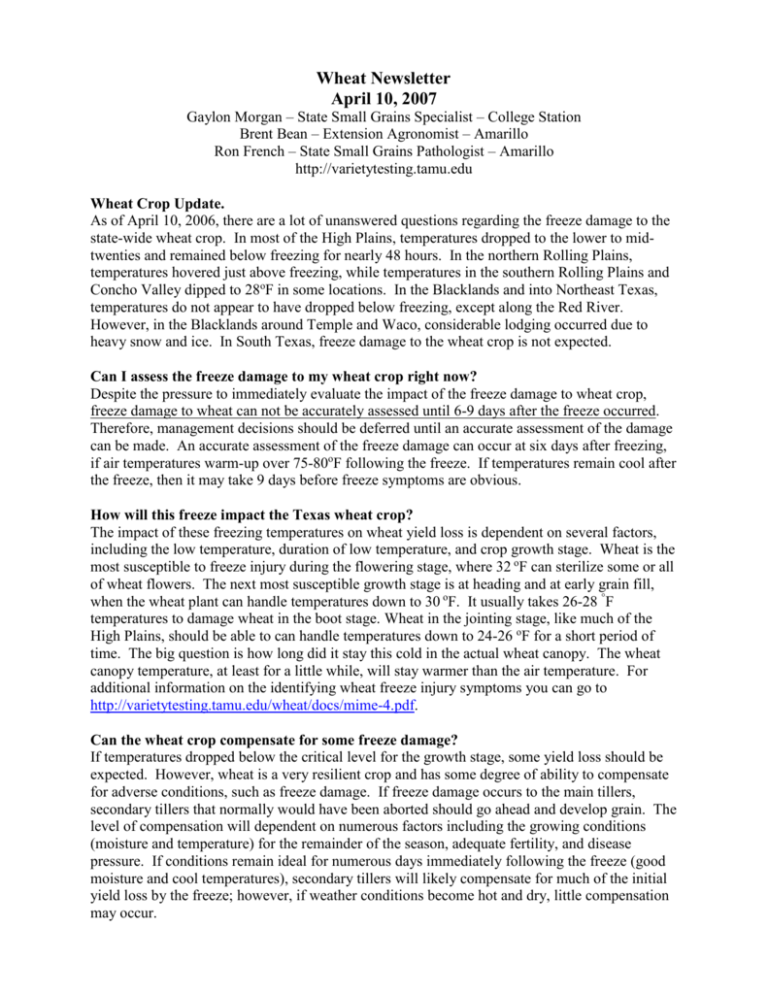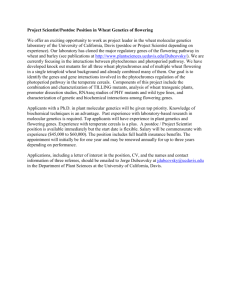Wheat Newsletter April 10 2007 v2
advertisement

Wheat Newsletter April 10, 2007 Gaylon Morgan – State Small Grains Specialist – College Station Brent Bean – Extension Agronomist – Amarillo Ron French – State Small Grains Pathologist – Amarillo http://varietytesting.tamu.edu Wheat Crop Update. As of April 10, 2006, there are a lot of unanswered questions regarding the freeze damage to the state-wide wheat crop. In most of the High Plains, temperatures dropped to the lower to midtwenties and remained below freezing for nearly 48 hours. In the northern Rolling Plains, temperatures hovered just above freezing, while temperatures in the southern Rolling Plains and Concho Valley dipped to 28oF in some locations. In the Blacklands and into Northeast Texas, temperatures do not appear to have dropped below freezing, except along the Red River. However, in the Blacklands around Temple and Waco, considerable lodging occurred due to heavy snow and ice. In South Texas, freeze damage to the wheat crop is not expected. Can I assess the freeze damage to my wheat crop right now? Despite the pressure to immediately evaluate the impact of the freeze damage to wheat crop, freeze damage to wheat can not be accurately assessed until 6-9 days after the freeze occurred. Therefore, management decisions should be deferred until an accurate assessment of the damage can be made. An accurate assessment of the freeze damage can occur at six days after freezing, if air temperatures warm-up over 75-80oF following the freeze. If temperatures remain cool after the freeze, then it may take 9 days before freeze symptoms are obvious. How will this freeze impact the Texas wheat crop? The impact of these freezing temperatures on wheat yield loss is dependent on several factors, including the low temperature, duration of low temperature, and crop growth stage. Wheat is the most susceptible to freeze injury during the flowering stage, where 32 oF can sterilize some or all of wheat flowers. The next most susceptible growth stage is at heading and at early grain fill, when the wheat plant can handle temperatures down to 30 oF. It usually takes 26-28 °F temperatures to damage wheat in the boot stage. Wheat in the jointing stage, like much of the High Plains, should be able to can handle temperatures down to 24-26 oF for a short period of time. The big question is how long did it stay this cold in the actual wheat canopy. The wheat canopy temperature, at least for a little while, will stay warmer than the air temperature. For additional information on the identifying wheat freeze injury symptoms you can go to http://varietytesting.tamu.edu/wheat/docs/mime-4.pdf. Can the wheat crop compensate for some freeze damage? If temperatures dropped below the critical level for the growth stage, some yield loss should be expected. However, wheat is a very resilient crop and has some degree of ability to compensate for adverse conditions, such as freeze damage. If freeze damage occurs to the main tillers, secondary tillers that normally would have been aborted should go ahead and develop grain. The level of compensation will dependent on numerous factors including the growing conditions (moisture and temperature) for the remainder of the season, adequate fertility, and disease pressure. If conditions remain ideal for numerous days immediately following the freeze (good moisture and cool temperatures), secondary tillers will likely compensate for much of the initial yield loss by the freeze; however, if weather conditions become hot and dry, little compensation may occur. How to assess the freeze damage. Remember, the diagnosis is only as good as the samples collected and evaluated. So, representative samples for the various growth stages should be collected from numerous areas within a field. Also, wheat varieties with different maturities should be inspected separately, because some varieties may by beginning to head while other varieties are flowering. Each field should be examined since small differences in environment and cultural practices can influence the amount of freeze damage that may have occurred. If wheat was in the jointing or early-boot stage, the stem should be sliced open to look for the immature wheat heads. The wheat head should be just above the last node (joint) and hollow part of the stem. If the wheat head and/or the flag-leaf is brownish or has a water soaked appearance, then that tiller will not produce grain. Usually this tiller will quit growing, but may stay green for several weeks. Wheat that was in the early jointing stage should have time for secondary tillers to make up a significant amount of the potential yield loss. If the wheat is heading or flowering, the flower parts will need to be inspected for damage. Healthy female flower parts (stigma) will have a feather appearance and should be a rich white color. See picture below for healthy flower parts prior to flowering (left) and at flowering (right). The male flower parts (anthers) will be a light green to yellow depending on the flowering stage. Any off-color or water-soaking appearance of the stigma or anther, means that wheat seed will not develop. This is a tedious job but is required for an accurate evaluation of the damage. Also, remember that the wheat flowers from the middle of the head outward to the ends. So, depending on the portion of the head that was flowering at time of the freeze, there may be blanks in only a portion of the head. Disease Update. Prior to the freeze last weekend, temperature, rainfall, and higher humidity was conducive for leaf rust development. In the Blacklands and South Texas, leaf rust has increased but the wheat is beyond the point where the disease can cause substantial yield losses. In the Rolling Plains, many farmers were applying fungicides last week for leaf rust on susceptible varieties. Stripe rust levels have remained very low in South Texas and virtually non-existent in other parts of the state. Powdery mildew remains present in the Blacklands and Rolling Plains, and in a few fields in the Panhandle, but in most cases is not at level that justifies a fungicide application. Below is a table from Dr. Bob Hunger at Oklahoma State University describing the expected yield loss at different wheat growth stages. As for wheat viruses, the Texas High Plains Plant Diagnostic Laboratory has recently received wheat samples from the Panhandle that have been infected with barley yellow dwarf virus (BYDV) or wheat streak mosaic virus (WSMV). Some samples from central Texas have been found to be infected with high plains virus (HPV), WSMV, or BYDV. Acknowledgements: Thanks to the many colleagues across the state for providing the regional crop updates. Contributors include: Todd Baughman, Extension Agronomist at Vernon; Jackie Rudd, Wheat Breeder at Amarillo; Russell Sutton, Research Associate at Dallas; Jim Swart, IPM agent at TAMU Commerce; Billy Warrick, Extension Agronomist at San Angelo. Additional information and previous newsletters can be found at the following web-page: http://varietytesting.tamu.edu. Table 1. Approximate percent loss of yield caused by leaf rust at combinations of leaf rust severity and growth stage of wheat. Severity (%) of leaf rust on the flag leaf Growth stage 10 25 40 65 100 ------------------Yield Loss (%)-----------------Flowering 10 15 20 30 35 Milk 2 5 8 14 20 Soft dough 1 3 4 7 10 Hard dough 1 1 1 3 5 an= anther, fs= stigma Image from the cd titled “WHEAT:THE BIG PICTURE” by Dr. Gary Barker.





